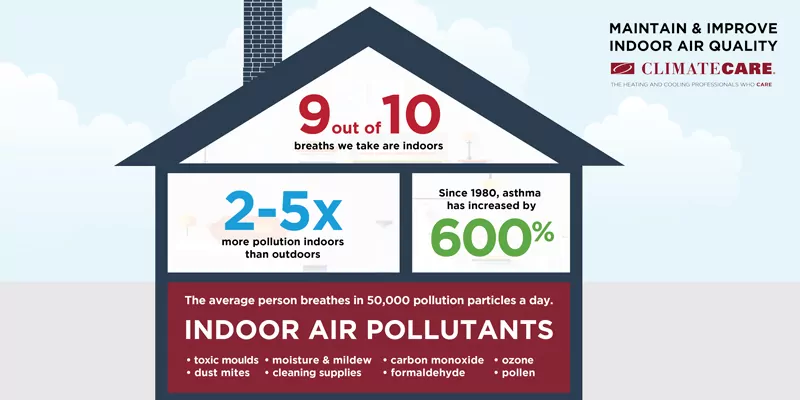
Your home is your base, your comfort zone, and, increasingly, the hub of nearly ALL your activity – where you live, sleep, and often, where you work. This past year has seen us all spending more time than ever before at home. And what does this increased time at home mean for our indoor air quality? It means you’re breathing in a lot more than just air.
Our team of ClimateCare technicians is getting asked more and more questions about home indoor air quality, so we thought we’d put together a brief overview on the topic.
So let’s dive in!
Why should I care about my indoor air quality?
- Research shows that 9 out of 10 breaths we take are indoors.
- Our indoor air is actually anywhere from 2 – 5 times more polluted than outdoors.
- The average person breathes in 50,000 pollution particles a day.
So what air pollutants might be lurking in my home?
- More than you think. Toxic moulds, moisture and mildew, carbon monoxide, ozone, dust mites, cleaning supplies, formaldehyde, and pollen.
Can indoor air quality affect the health of my family?
- Yes, in fact, 50 % of all illness is due to poor indoor air quality.
- If you’re an asthma sufferer or are susceptible to environmental allergens, poor indoor air quality can make life quite unpleasant.
What’s the bottom line?
Reducing the toxins that you breathe can have a very profound and dramatic impact on your health.
Now that we got that out of the way, let’s dive into 3 things you can do right now to make immediate improvements to your indoor air quality.
1. Sometimes, the best advice is the most obvious advice.
The best thing you can do for your indoor air quality this spring is to open a window!
Ventilation is an essential strategy when it comes to improving the quality of air inside our homes. According to Health Canada and the Canada Mortgage and Housing Corporation, ventilation is needed to direct fresh air into the home to improve air quality and increase your home comfort. Without enough ventilation in your space, you can experience discomfort issues and even health problems. Fresh air is vital to human health. Period.
Expert Fresh Air Hack: Run your bathroom fan for a couple of hours every day. This fan ventilates stale air but, it also pulls air directly from outside. It’s a myth that this should only be on when you’re in the bathroom. (Mind-blowing, right?)
2. Keep it Clean
A house free of dust and pet hair is a healthier house. Good indoor hygiene can greatly cut down on dust and animal dander. Your cleaning efforts should focus on strategies to reduce the accumulation of pet dander, mould, and dust lurking in your home. Vacuum, vacuum, vacuum!
3. Get hip to the HEPA
Are you a family of allergy sufferers? Do you have pets? If so, you might want to consider taking your air quality to the next level by installing a HEPA (High-Efficiency Particulate Arrestor) filter which can improve air quality by reducing debris, allergens, dust, bacteria, mould spores, and many viruses from the air. In fact, a HEPA filter will catch 99.97% of the particulates in the air.
This is a relatively low-cost addition to your home comfort arsenal and can make a huge difference. Think a HEPA might be right for you? Here’s a full rundown of how they work and their benefits.
Breathe Easier with ClimateCare’s Expert Services
We care about the air you and your family breathe. If you have any concerns about your indoor air quality, contact your local ClimateCare today.
You can also download our free guide, A Home Comfort Overhaul for a New Normal. It’s full of DIY tips and advice from our experts.




